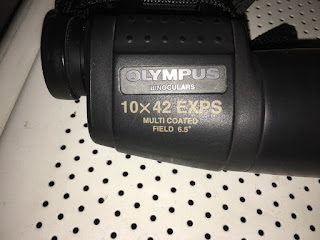Many times, during our public astronomy nights, people have asked about buying a telescope. If this request comes from someone who has just looked through a telescope for the first time, I recommended to start with binoculars. This is the second step after having acquired at least a little familiarity with "naked eye" constellation, location of some of the major "targets", and the their seasonal visibility. I also explain the reason for the timing on the orbital position of the Earth in its orbit around the sun.
Having used telescopes for most of my life, I always use binoculars as helpers to locate objects I want to look at. I am talking here about finding them "manually", not using computerized telescopes. In many cases, people already own some binoculars, they've just never thought of using them to look at the sky. Most of these "found" binoculars are quite suitable for this kind of use.
For astronomical purposes, binoculars with larger front lenses are better. Astronomical objects, other than the Moon and the bright planets, tend to be quite faint; the larger the front lens, the more light you gather, that makes these faint targets easier to see. Personally, I use two pairs of binoculars with the magnifying power (power equals magnification) of 10 and one stabilized pair with the power of 15 (see fig. 1, left to right).
Generally, the larger binoculars become, the heavier they are. In this group of binoculars, above, the OLYMPUS pair is the lightest, while the Canon pair is the heaviest - it contains the stabilizing electronics, as well as a battery, in addition the internal prisms which make the image appear upright. All commonly available binoculars shown are, in a basic sense, refractor type telescopes, which will normally show an upside down image. Additional optical components are needed to turn the image around once more; that delivers an "upside down upside down" image. Galileo would have given his eye-teeth to have a telescope of the quality in today's refractors and their derivatives, i.e. binoculars.
I should also mention the effect of what is called the "exit pupil" of any optical telescope, including binoculars. The exit pupil can be seen by looking at the eyepiece (the lenses where you place your eye(s) to look through a telescope). Exit pupil diameter, usually stated in mm, should match the diameter of your eyes' pupils when you use binoculars. Exit pupils are the front lenses projected by the eyepieces, and therefore contain all the light entering the front lenses (see fig. 5). If your own eye pupils, which vary their diameter depending on the brightness at which you are looking is high, your pupils contract (become smaller). If your eye pupil is smaller than the exit pupils of your binoculars, you automatically discard some of the light which is contained in the binocular's exit pupils. This is no problem when you use your binoculars during the day, but for Astronomy, you usually look at very faint objects and you want to get all the light that you can catch in the objective lenses.
There is a simple way to calculate the diameter of telescope or binocular exit pupil diameter:
DIAMETER divided by POWER i.e. 50 divided by 10 = 5mm
42 divided by 10 = 4.2mm
50 divided by 15 = 3.3mm
When you are young, your eye pupils can expand to about 7mm in deep darkness. That's why 7 x 50 binoculars are used in the navy. Most sailors tend to be young, and can make use of all the light coming into the binoculars at night. As you get older, the maximum "dark adapted" pupil diameter tends to get smaller. For instance, at age 50 you may only have a 5mm "dark adapted" pupil diameter. I'm way past that age, so my pupil diameter may possibly expand to less than that. Again, if your pupils match the diameter of exit pupil, you see all the light that your telescope or binoculars can catch. Any pair of binoculars worth their salt will also show you the larger craters on the Moon, the Galilean moons of Jupiter, brighter open and globular star clusters, movements of the planets and other interesting astronomical wonders. Much of this information is found in the RASC's Observers Handbook (free if you are a member).
As a couple of examples, there are detailed descriptions of the technical aspects of binoculars by Dr. Roy Bishop contained in the RASC's Observers Handbook, starting on page 60 in the 2019 edition. Wikipedia also contains information about binoculars.
Think of how much more light the objective lenses of telescopes and binoculars can intercept than your own pupils (50mm versus 5mm, say). It is the ratio of the disk area of a 50mm objective lens and 5 mm exit pupil you need to consider.
You can see what a great visual aid binoculars can be when using them to look at the sky at night.





No comments:
Post a Comment